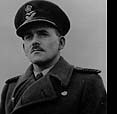Cars - a failure?
Jet Engines, No-Propeller Plane for R.A.F.
THE FASTEST THING IN THE SKIES
By Courtenay Edwards
Fighter planes with no propellers, invented by a former "crazy flyer" at Hendon air displays, and with a top speed probably greater than that of any other aircraft now flying, will soon go into production in Britain, it was officially announced last night.
 Frank Whittle |
Working behind locked doors for the last 11 years, he has perfected an invention which may have a tremendous influence on air transport in the years to come.
Last night's announcement that "jet propelled fighter aircraft have successfully passed experimental tests and will soon be in production" clears up a mystery which has puzzled thousands of people living near certain English airfields.
They have often been startled, in recent months, by strange-looking aircraft tearing across the sky at amazing speeds and making weird noises unlike any they had ever before heard an aircraft produce.
Small boys have written letters to aircraft firms and other bodies naively asking for details of the funny aeroplanes that whizz across the sky and just go "pouff!"
In simple language - a jet-propelled aircraft is pushed through the air by a powerful jet of compressed air expelled from the rear of the plane after being drawn in at the front, compressed, heated, and mixed with fuel injected into a special chamber and then ignited.
It has been known for some years that other nations, including Germany and Italy, have been working on jet propulsion. Little was known of the experiments which we now know were going on in this country.
Last night's announcement discloses that Britain has played a leading part in this branch of aeronautical research.
It was in 1933 that Group Captain Whittle, then a flying officer, began work on the engines which, in their improved form, will be installed in the new fighters to produce the propulsive jet.
They will probably have a top speed of between 500 and 600 miles an hour.
Whittle's first engine ran successfully in 1937, and two years later the Air Ministry ordered its first jet propulsion plane from the Gloster Aircraft Co., Ltd., of Gloucester.
It was arranged that special engines for these experimental models were to be made by a firm known as Power Jets Ltd. at a secret factory.
Group Captain Whittle was lent to this firm. And in May 1941 the first successful flight was made.
The pilot was the late Flight Lieut. P. E. G. ("Jerry") Sayer, chief test pilot of the Gloster Aircraft Company, who died in October 1942.
Since then several hundred flights have been made by British pilots in England and the United States, many at high altitudes and extreme speed - and all without one mishap.
The Americans have been helping with the development of the Whittle engine since September 1941, when the engine which made the first flight was sent over there at the request of General H. H. Arnold, Chief of the United States Army Air Forces.
A number of these engines were built in America, the first being ready for test within six months. At the same time the Bell Aircraft Co. was given an order to build an aircraft "suitable to take two of these engines" and the first jet-propelled flight in the United States was made in under 12 months.
"In view of the obvious advantage of this new type of aircraft," I was told last night, "Instructions have been issued on both sides of the Atlantic to plan the production of a sufficient quantity for training purposes both in the United States and Great Britain."
This suggests that RAF and Americans will be trained, on these first production models, to fly improved combat types to be produced later.
A number of advantages are claimed for the jet-propelled aircraft over the ordinary, propeller-driven type.
First, it is claimed that with engines of much lower power than those needed in a comparable plane of orthodox design, much higher speeds can be obtained.
The engines needed to create and expel the jet are simpler in design, easier to maintain and more reliable.
Absence of airscrews gives an undisturbed airflow over wings and fuselage, with a consequent reduction in drag, and also permits the use of shorter undercarriages. This makes it easier for passengers to get on and off.
It seems likely that at its present stage of development, jet propulsion offers advantages only in the smallest types of aircraft, such as the fighter planes soon to be built.
In years to come giant air liners may all be jet-propelled, but I have been told by some of the country's leading aeronautical engineers that this form of propulsion is unlikely to be adapted for the larger planes for about five to eight years.
I understand that heavy fuel consumption is one of the problems to be solved before jet propulsion can become of any great value to commercial flying.
After his first engine ran successfully in 1937, Group Capt. Whittle was placed on the Air Ministry's special duty list to continue his research work.
Leaving Leamington College, in 1923, to become an RAF apprentice, he did so well that he was awarded a cadetship at Cranwell. He became a pilot officer in a fighter squadron in 1928, and first started work on his jet propulsion theories while on an instructor's course at the Central Flying School.
Whittle's home is at Rugby and he has two boys, David, aged 12, and Ian, aged 9
The late Flight Lieut. Sayer, first man to fly Britain's first jet-propelled aircraft was one of Britain's finest test pilots.

